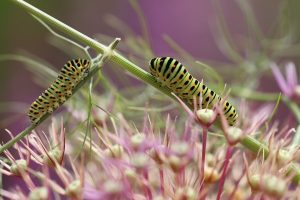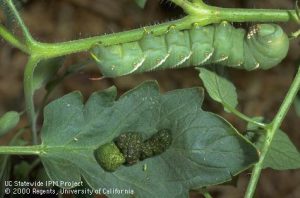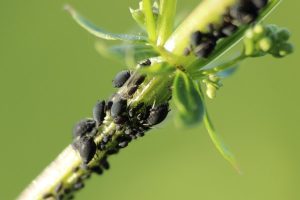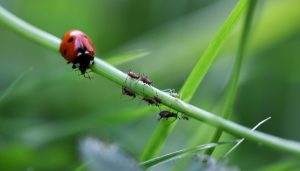By Helen Willoughby-Peck, UC Master Gardener, Mariposa County
Walking in your garden every day is good for you and good for your plants. Observing your plants on a regular basis helps control pests that may be enjoying your tomatoes before you can. When caught early they are usually easy to control without insecticides or other drastic action.

Image by Roland Steinmann.
You can get any number of pests in your garden, on your tomato plants, as well as other veggies. Mites, beetles, thrips, whiteflies, caterpillars, aphids, leaf miners, etc. But don’t be discouraged. Tomato plants are hearty, and pests can usually be managed without insecticides. Diligent observation, knowing the difference between pest insects and beneficial insects, and dealing with problems as soon as they appear will go a long way.

Tomato Hornworm.
One common and easily controlled pest is the tomato hornworm. If you notice sudden defoliation of your tomato plant or large holes gnawed into the tomato fruit, it’s likely a tomato hornworm. They are tricky to find since they blend in so well with the plant leaves.
First, check the leaves and ground below the plant for 1/16th inch black pellets of excrement is a telltale sign. Look straight up from there and you will find a hornworm, usually about the size of a finger. Or use a blacklight flashlight at night. A tomato hornworm will appear much brighter than the plant foliage making them very easy to locate. Hand pick them off the plant and drop them in a pail of water.

Aphids. (Image by Heiko Stein).
Aphids can sometimes be a problem. Look under your leaves or on tender new growth for tiny, oval, green, yellowish, or black insects and use a sharp spray from a hose to remove them. Or, for heavy infestations, spray them with neem oil which is a naturally occurring and less toxic pesticide.
Birds sometimes can eat your mature tomatoes. Devices that scare birds from your garden are varied and plentiful and can be as easy as placing a stake in your garden with a reflective tape clipped to it that moves with the air current.

Image by Annette Meyer.
It is best to accurately identify any pests that you are concerned with. Many pests need no control unless infestations are very severe and many are kept under good control by natural predators or parasites; other insects that eat them or lay their eggs in them.
If insecticidal control is needed be sure to use a product that is specific to the pest. Broad-spectrum insecticides can cause more harm than good by destroying beneficial insects that prey on the pest insects and consequently cause an upset to nature’s insect balance. By destroying beneficial insects there is an increased possibility of a surge in the populations of pests because their natural insect enemies have been destroyed.
About UC Master Gardeners of Mariposa County
UC Master Gardeners of Mariposa County is located at 5009 Fairgrounds Road, Mariposa, CA. For more gardening and event information, visit their website or Facebook page (UC Master Gardeners of Mariposa County).
UC Master Gardeners staff a helpline serving Mariposa County, including Greeley Hill, Coulterville, and Lake Don Pedro. Please contact them at 209-966-7078 or via e-mail at mgmariposa@ucdavis.edu.
Listen to them on the radio at KRYZ 98.5 FM on Wednesdays at 2 p.m and Saturdays at 5 p.m.





